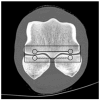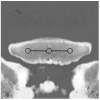Characterization of Normal Bone in the Equine Distal Limb with Effective Atomic Number and Electron Density Determined with Single-Source Dual Energy and Detector-Based Spectral Computed Tomography
- PMID: 38612304
- PMCID: PMC11010807
- DOI: 10.3390/ani14071064
Characterization of Normal Bone in the Equine Distal Limb with Effective Atomic Number and Electron Density Determined with Single-Source Dual Energy and Detector-Based Spectral Computed Tomography
Abstract
Single-source dual energy (SSDECT) and detector-based spectral computed tomography (DBSCT) are emerging technologies allowing the interrogation of materials that have different attenuation properties at different energies. Both technologies enable the calculation of effective atomic number (EAN), an index to determine tissue composition, and electron density (ED), which is assumed to be associated with cellularity in tissues. In the present prospective observational study, EAN and ED values were determined for 16 zones in normal subchondral and trabecular bone of 37 equine cadaver limbs. Using both technologies, the following findings were obtained: 1. palmar/plantar EAN zone values in the fetlock increased significantly with increasing age of the horse; 2. all EAN and ED values were significantly lower in the trabecular bone than in the subchondral bone of all phalanges; 3. in the distal phalanx and navicular bone, most EAN and ED values were significantly lower compared to the proximal and middle phalanx; and 4. some EAN and ED values were significantly different between front and hind limbs. Several EAN and ED values significantly differed between SSDECT and DBSCT. The reported EAN and ED values in the subchondral and trabecular bone of the equine distal limb may serve as preliminary reference values and aid future evaluation and classification of diseases.
Keywords: computed tomography; dual energy; effective atomic number; electron density; equids; subchondral bone.
Conflict of interest statement
The authors declare no conflicts of interest.
Figures




Similar articles
-
Clinical application of effective atomic number for classifying non-calcified coronary plaques by dual-energy computed tomography.Atherosclerosis. 2017 Jun;261:138-143. doi: 10.1016/j.atherosclerosis.2017.03.025. Epub 2017 Mar 21. Atherosclerosis. 2017. PMID: 28372786
-
Stopping-power ratio estimation for proton radiotherapy using dual-energy computed tomography and prior-image constrained denoising.Med Phys. 2023 Mar;50(3):1481-1495. doi: 10.1002/mp.16063. Epub 2022 Nov 17. Med Phys. 2023. PMID: 36322128
-
A stoichiometric calibration method for dual energy computed tomography.Phys Med Biol. 2014 Apr 21;59(8):2059-88. doi: 10.1088/0031-9155/59/8/2059. Epub 2014 Apr 2. Phys Med Biol. 2014. PMID: 24694786
-
Improving the Accuracy of the Effective Atomic Number (EAN) and Relative Electron Density (RED) with Stoichiometric Calibration on PCD-CT Images.Sensors (Basel). 2022 Nov 27;22(23):9220. doi: 10.3390/s22239220. Sensors (Basel). 2022. PMID: 36501922 Free PMC article.
-
Does subchondral bone of the equine proximal phalanx adapt to race training?J Anat. 2016 Jul;229(1):104-13. doi: 10.1111/joa.12478. Epub 2016 Apr 14. J Anat. 2016. PMID: 27075139 Free PMC article.
Cited by
-
Dual-Energy Computed Tomography for the Detection of Bone Edema-Like Lesions in the Equine Foot: Standing Horses and Cadaveric Specimens.Vet Sci. 2025 Jun 24;12(7):614. doi: 10.3390/vetsci12070614. Vet Sci. 2025. PMID: 40711274 Free PMC article.
References
LinkOut - more resources
Full Text Sources

